Influence of Particle Size on the Low-Temperature Nitrogen Adsorption of Deep Shale in Southern Sichuan, China
Abstract
:1. Introduction
2. Materials and Methods
2.1. Samples
2.2. Low Temperature Nitrogen Adsorption Experiment
3. Results and Discussion
3.1. Adsorption–Desorption Curve Characteristics
3.2. Comparative Analysis of Pore Volume
3.3. Specific Surface Area Analysis
3.4. Comparative Analysis of the Fractal Dimension
4. Conclusions
- Grain size has a great effect on pore volume and pore distribution measurements. The total shale pore volume measurements showed a small increase followed by a large increase as the grain size decreases, which is not significantly related to TOC.
- The particle size exerts a certain influence on the accuracy of the fractal dimension and the correlation coefficient of the fractal dimension increases significantly as the particle size of the sample decreases. Furthermore, the complexity of the pore structure of deep samples is influenced by more controlling factors. The use of 200–400 mesh size samples is recommended when studying fractal dimensions.
- The micropores and small mesopores (<20 nm) of the shale samples provide many pore volumes and this intensifies with increasing burial depth. Isolated pores are developed in larger mesopores and macropores (>20 nm) and further analysis is needed under reservoir conditions.
- The specific surface area of shale is almost unaffected by the particles’ size. The surface area’s size is mainly controlled by the micropores and small pore size mesopores. The specific surface area of the small pores contributes most of the total specific surface area of deep shale samples.
- There are different requirements for the sample mesh for the study of different shale characteristics by nitrogen adsorption. Among them, 120~160 mesh size samples are recommended for the study of pore volume, and 200~400 mesh size samples are recommended for the study of the fractal dimension. The study of specific surface area grid samples has no specific grid requirements.
Author Contributions
Funding
Data Availability Statement
Conflicts of Interest
References
- Vidic, R.D.; Brantley, S.L.; Vandenbossche, J.M.; Yoxtheimer, D.; Abad, J.D. Impact of shale gas development on regional water quality. Science 2013, 340, 1235009. [Google Scholar] [CrossRef] [PubMed] [Green Version]
- Zhang, L.H.; He, X.; Li, X.G.; Li, K.C.; He, J.; Zhang, Z.; Guo, J.J.; Chen, Y.N.; Liu, W.S. Shale gas exploration and development in the Sichuan Basin: Progress, challenge and countermeasures. Nat. Gas Ind. 2021, 41, 143–152. [Google Scholar]
- Ma, X.H.; Li, X.Z.; Liang, F.; Wan, Y.J.; Shi, Q.; Wang, Y.H.; Zhang, X.W.; Che, M.G.; Guo, W. Dominating factors on well productivity and development strategies optimization in Weiyuan shale gas play, Sichuan Basin, SW China. Pet. Explor. Dev. 2020, 47, 594–602. [Google Scholar] [CrossRef]
- Li, X.Z.; Guo, Z.H.; Hu, Y.; Liu, X.H.; Wan, Y.J.; Luo, R.L.; Sun, Y.P.; Che, M.G. High-quality development of ultra-deep large gas fields in China: Challenges, strategies and proposals. Nat. Gas Ind. 2020, 40, 75–82. [Google Scholar] [CrossRef]
- Liu, S.G.; Deng, B.; Zhong, Y.; Ran, B.; Yong, Z.Q.; Sun, W.; Yang, D.; Jiang, L.; Ye, Y.H. Unique geological features of burial and superimposition of the Lower Paleozoic shale gas across the Sichuan Basin and its periphery. Earth Sci. Front. 2016, 23, 11–28. [Google Scholar]
- Nie, H.K.; Bian, R.K.; Zhang, P.X.; Gao, B. Micro-types and characteristics of shale reservoir of the lower paleozoic in southeast Sichuan basin, and their effects on the gas content. Earth Sci. Front. 2014, 21, 331–343. [Google Scholar]
- Chen, Y.; Wei, L.; Mastalerz, M.; Schimmelmann, A. The effect of analytical particle size on gas adsorption porosimetry of shale. Int. J. Coal Geol. 2015, 138, 103–112. [Google Scholar] [CrossRef] [Green Version]
- Alsalem, O.B.; Fan, M.; Xie, X. Late Paleozoic subsidence and burial history of the Fort Worth basin. AAPG Bull. 2017, 101, 1813–1833. [Google Scholar] [CrossRef]
- Hao, F.; Zou, H.Y.; Lu, Y.C. Mechanisms of shale gas storage: Implications for shale gas exploration in China. AAPG Bull. 2013, 97, 1325–1346. [Google Scholar] [CrossRef]
- Hou, B.; Diao, C.; Li, D.D. An experimental investigation of geomechanical properties of deep tight gas reservoirs. J. Nat. Gas Sci. Eng. 2017, 47, 22–33. [Google Scholar] [CrossRef]
- Guan, Q.Z.; Dong, D.Z.; Lu, H.; Liu, B. Influences of abnormal high pressure on Longmaxi shale gas reservoir in Sichuan Basin. Xinjiang Pet. Geol. 2015, 36, 55–60. [Google Scholar]
- Anovitz, L.M.; Cole, D.R. Characterization and analysis of porosity and pore structures. Rev. Mineral. Geochem. 2015, 80, 61–164. [Google Scholar] [CrossRef] [Green Version]
- Loucks, R.G.; Reed, R.M. Abstract: Scanning-electron-microscope petrographic evidence for distinguishing organic-matter pores associated with depositional organic matter versus migrated organic matter in mudrocks. Gcags Trans. 2014, 3, 51–60. [Google Scholar]
- Liu, W.B.; Zhang, S.Q.; Li, S.Z.; Zhou, X.G.; Wang, D.D.; Zhang, W.H.; Lin, Y.H. Development characteristics and geological significance of microfractures in the Es3 reservoirs of Dongpu depression. Geol. Bull. China 2018, 37, 496–502. [Google Scholar]
- Lin, W.; Xiong, S.C.; Liu, Y.; He, Y.; Chu, S.S.; Liu, S.Y. Spontaneous imbibition in tight porous media with different wettability: Pore-scale simulation. Phys. Fluids 2021, 33, 032013. [Google Scholar] [CrossRef]
- Sun, J.M.; Dong, X.; Wang, J.J.; Schmitt, D.R.; Xu, C.L.; Mohammed, T.; Chen, D.W. Measurement of total porosity for gas shales by gas injection porosimetry (GIP) method. Fuel 2016, 186, 694–707. [Google Scholar] [CrossRef]
- Hu, H.Y.; Zhang, T.W.; Wiggins-Camacho, J.D.; Ellis, G.S.; Lewan, M.D.; Zhang, X.L. Experimental investigation of changes in methane adsorption of bitumen-free Woodford Shale with thermal maturation induced by hydrous pyrolysis. Mar. Pet. Geol. 2015, 59, 114–128. [Google Scholar] [CrossRef]
- Yang, F.; Ning, Z.F.; Kong, D.T.; Liu, H.Q. Pore structure of shale from high pressure mercury injection and nitrogen adsorption method. Nat. Gas Geosci. 2013, 24, 450–455. [Google Scholar]
- Ramirez, T.R.; Klein, J.D.; Ron, J.M.; Howard, J.J. Comparative study of formation evaluation methods for unconventional shale gas reservoirs: Application to the Haynesville shale (Texas). In Proceedings of the SPE North American Unconventional Gas Conference and Exhibition, The Woodlands, TX, USA, 14–16 June 2011. [Google Scholar]
- Xu, H.; Tang, D.Z.; Zhao, J.L.; Li, S. A precise measurement method for shale porosity with low-field nuclear magnetic resonance: A case study of the Carboniferous–Permian strata in the Linxing area, eastern Ordos Basin, China. Fuel 2015, 143, 47–54. [Google Scholar] [CrossRef]
- Yang, F.; Ning, Z.F.; Liu, H.Q. Fractal characteristics of shales from a shale gas reservoir in the Sichuan Basin, China. Fuel 2014, 115, 378–384. [Google Scholar] [CrossRef]
- Hinai, A.A.; Rezaee, R.; Esteban, L.; Labani, M. Comparisons of pore size distribution: A case from the Western Australian gas shale formations. J. Unconv. Oil Gas Resour. 2014, 8, 1–13. [Google Scholar] [CrossRef]
- Yin, L.L.; Guo, S. Full-sized pore structure and fractal characteristics of marine-continental transitional shale: A case study in Qinshui basin, North China. Acta Geol. Sin. 2019, 93, 675–691. [Google Scholar] [CrossRef]
- Wei, M.M.; Xiong, Y.Q.; Zhang, L.; Li, J.H.; Peng, P.A. The effect of sample particle size on the determination of pore structure parameters in shales. Int. J. Coal Geol. 2016, 163, 177–185. [Google Scholar] [CrossRef]
- Li, J.; Zhou, S.X.; Fu, D.L.; Li, Y.J.; Ma, Y.; Yang, Y.N.; Li, C.C. Changes in the pore characteristics of shale during comminution. Energy Explor. Exploit. 2016, 34, 676–688. [Google Scholar] [CrossRef] [Green Version]
- Han, H.; Cao, Y.; Chen, S.J.; Lu, J.G.; Huang, C.X.; Zhu, H.H.; Zhan, P.; Gao, Y. Influence of particle size on gas-adsorption experiments of shales: An example from a Longmaxi Shale sample from the Sichuan Basin, China. Fuel 2016, 186, 750–757. [Google Scholar] [CrossRef] [Green Version]
- Mastalerz, M.; Hampton, L.; Drobniak, A.; Loope, H. Significance of analytical particle size in low-pressure N2 and CO2 ad-sorption of coal and shale. Int. J. Coal Geol. 2017, 178, 122–131. [Google Scholar] [CrossRef]
- Jiao, K.; Ye, Y.H.; Liu, S.G.; Ran, B.; Deng, B.; Li, Z.W.; Li, J.X.; Yong, Z.Q.; Jiang, L.; Xia, G.D.; et al. Nanopore characteristics of super-deep buried mudstones in Sichuan Basin and its geological implication. J. Chengdu Univ. Technol. Sci. Technol. Ed. 2017, 44, 129–138. [Google Scholar] [CrossRef]
- He, Z.L.; Nie, H.K. Geological problems in the effective development of deep shale gas taking Sichuan Basin and its surrounding Wufeng Formation-Longmaxi Formation as an example. Acta Pet. Sin. 2020, 41, 379–391. [Google Scholar]
- Yang, F.; Xu, S.; Hao, F.; Hu, B.Y.; Zhang, B.Q.; Shu, Z.G.; Long, S.Y. Petrophysical characteristics of shales with different lithofacies in Jiaoshiba area, Sichuan Basin, China: Implications for shale gas accumulation mechanism. Mar. Pet. Geol. 2019, 109, 394–407. [Google Scholar] [CrossRef]
- Yang, F.; Xie, C.; Ning, Z.F.; Krooss, B.M. High-pressure methane sorption on dry and moisture-equilibrated shales. Energy Fuels 2017, 31, 482–492. [Google Scholar] [CrossRef]
- Barrett, E.P.; Joyner, L.G.; Halenda, P.P. The determination of pore volume and area distributions in porous substances. I. Computations from nitrogen isotherms. J. Am. Chem. Soc. 1951, 73, 373–380. [Google Scholar] [CrossRef]
- Thommes, M. Physical adsorption characterization of nanoporous materials. Chem. Ing. Tech. 2010, 82, 1059–1073. [Google Scholar] [CrossRef]
- Li, B.; Chen, F.W.; Xiao, D.S.; Lu, S.F.; Zhang, L.C.; Zhang, Y.Y.; Gong, C. Effect of particle size on the experiment of low temperature nitrogen adsorption: A case study of marine gas shale in Wufeng-Longmaxi formation. J. China Univ. Min. Technol. 2019, 48, 395–404. [Google Scholar] [CrossRef]
- Thommes, M.; Kaneko, K.; Neimark, A.V.; Olivier, J.P.; Rodriguez-Reinoso, F.; Rouquerol, J.; Sing, K.S.W. Physisorption of gases, with special reference to the evaluation of surface area and pore size distribution (IUPAC Technical Report). Pure Appl. Chem. 2015, 87, 1051–1069. [Google Scholar] [CrossRef] [Green Version]
- Xie, X.Y.; Tang, H.M.; Wang, C. Comparison of nitrogen adsorption method and mercury injection method in testing pore size distribution of shale. Nat. Gas Ind. 2006, 26, 100–102. [Google Scholar] [CrossRef]
- Liu, X.J.; Xiong, J.; Liang, L.X. Investigation of pore structure and fractal characteristics of organic-rich Yanchang formation shale in central China by nitrogen adsorption/desorption analysis. J. Nat. Gas Sci. Eng. 2015, 22, 62–72. [Google Scholar] [CrossRef]
- Lin, W.; Li, X.Z.; Yang, Z.M.; Lin, L.J.; Xiong, S.C.; Wang, Z.Y.; Wang, X.Y.; Xiao, Q.H. A new improved threshold segmentation method for scanning images of reservoir rocks considering pore fractal characteristics. Fractals 2018, 26, 1840003. [Google Scholar] [CrossRef] [Green Version]
- Xie, D.L.; Guo, Y.H.; Zhao, D.F. Fractal characteristics of adsorption pore of shale based on low temperature nitrogen experiment. J. China Coal Soc. 2014, 39, 2466–2472. [Google Scholar]
- Pfeifer, P.; Wu, Y.J.; Cole, M.W.; Krim, J. Multilayer adsorption on a fractally rough surface. Phys. Rev. Lett. 1989, 62, 1997–2000. [Google Scholar] [CrossRef]
- Liang, L.X.; Xiong, J.; Liu, X.J. An investigation of the fractal characteristics of the Upper Ordovician Wufeng Formation shale using nitrogen adsorption analysis. J. Nat. Gas Sci. Eng. 2015, 27, 402–409. [Google Scholar] [CrossRef]
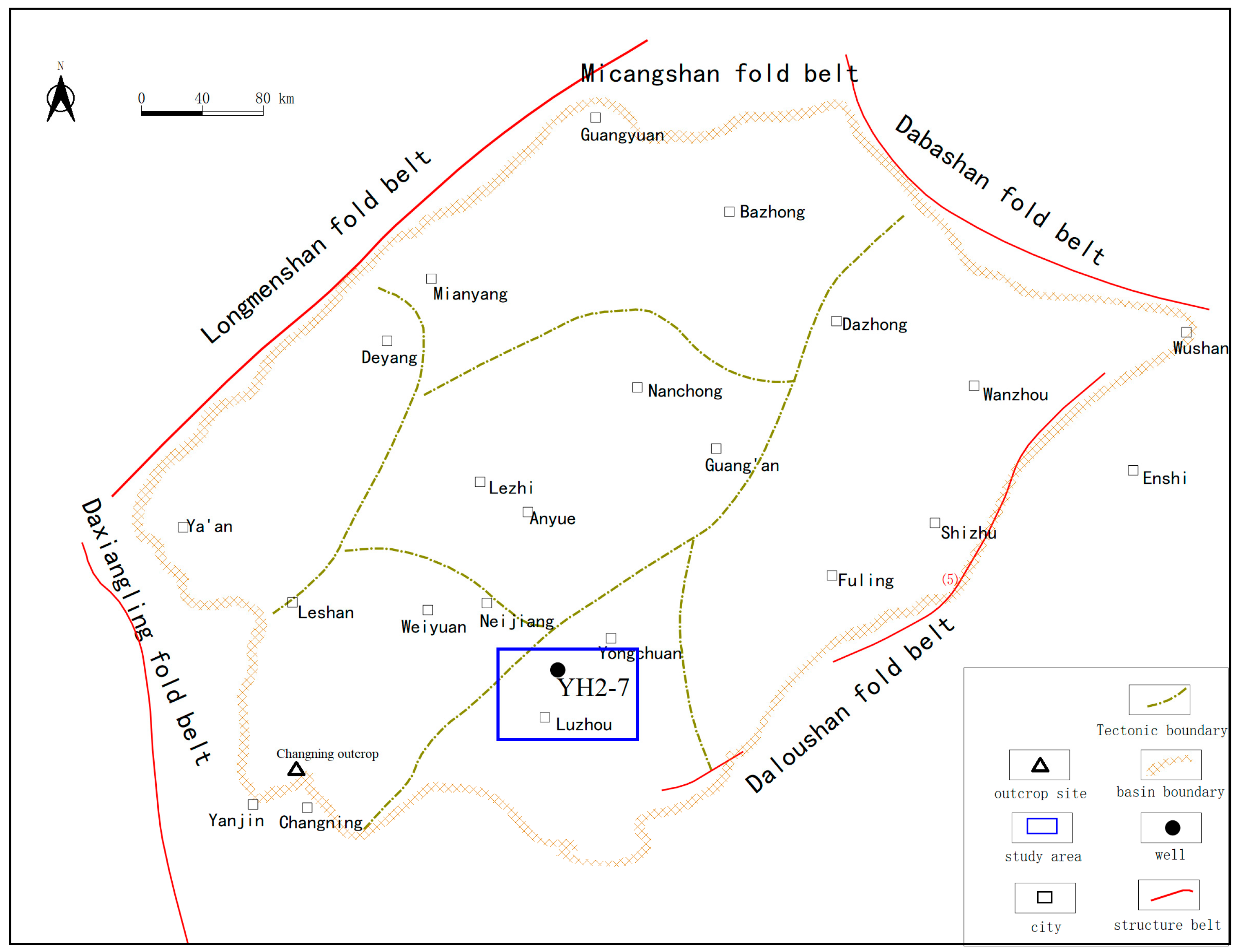
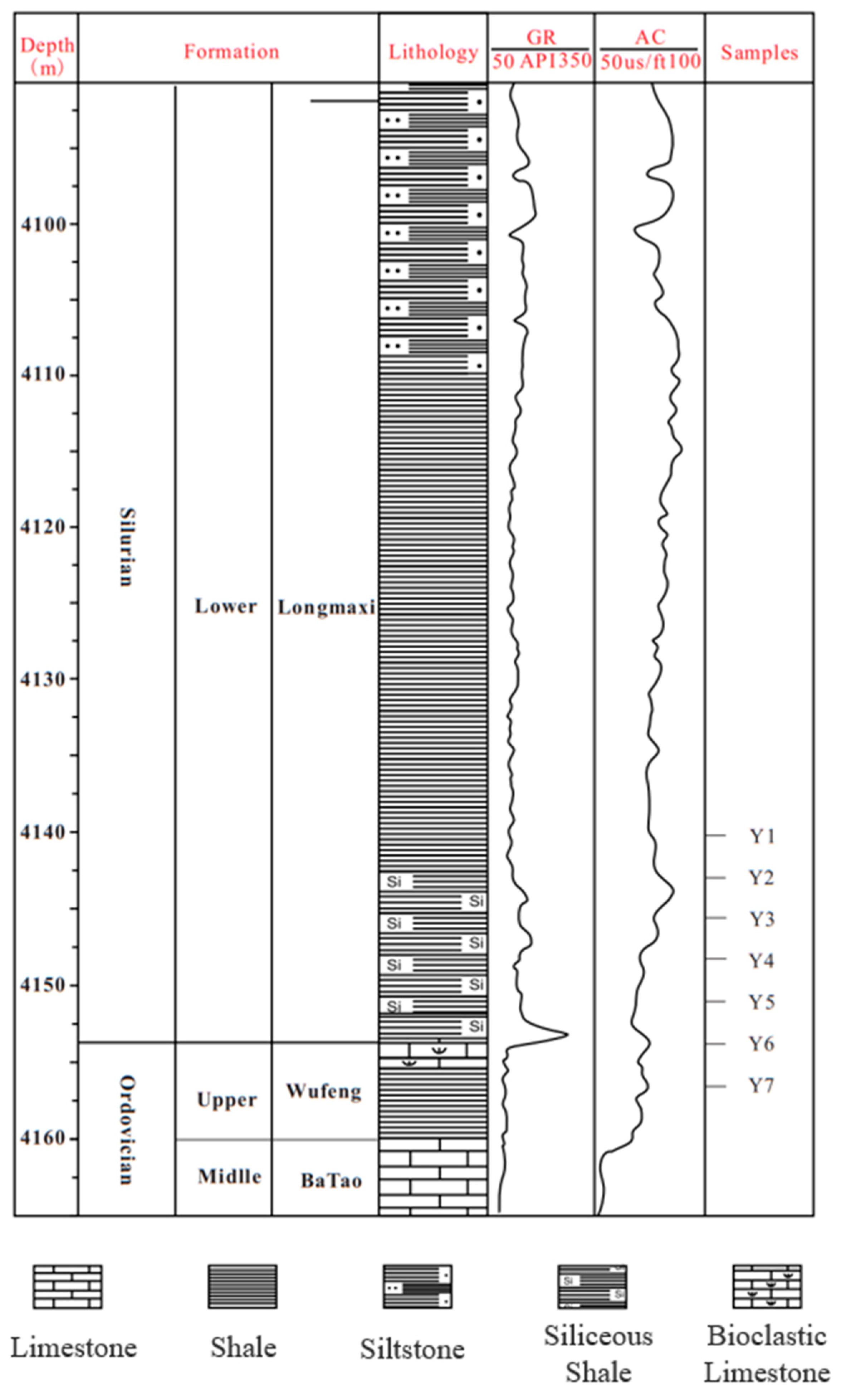
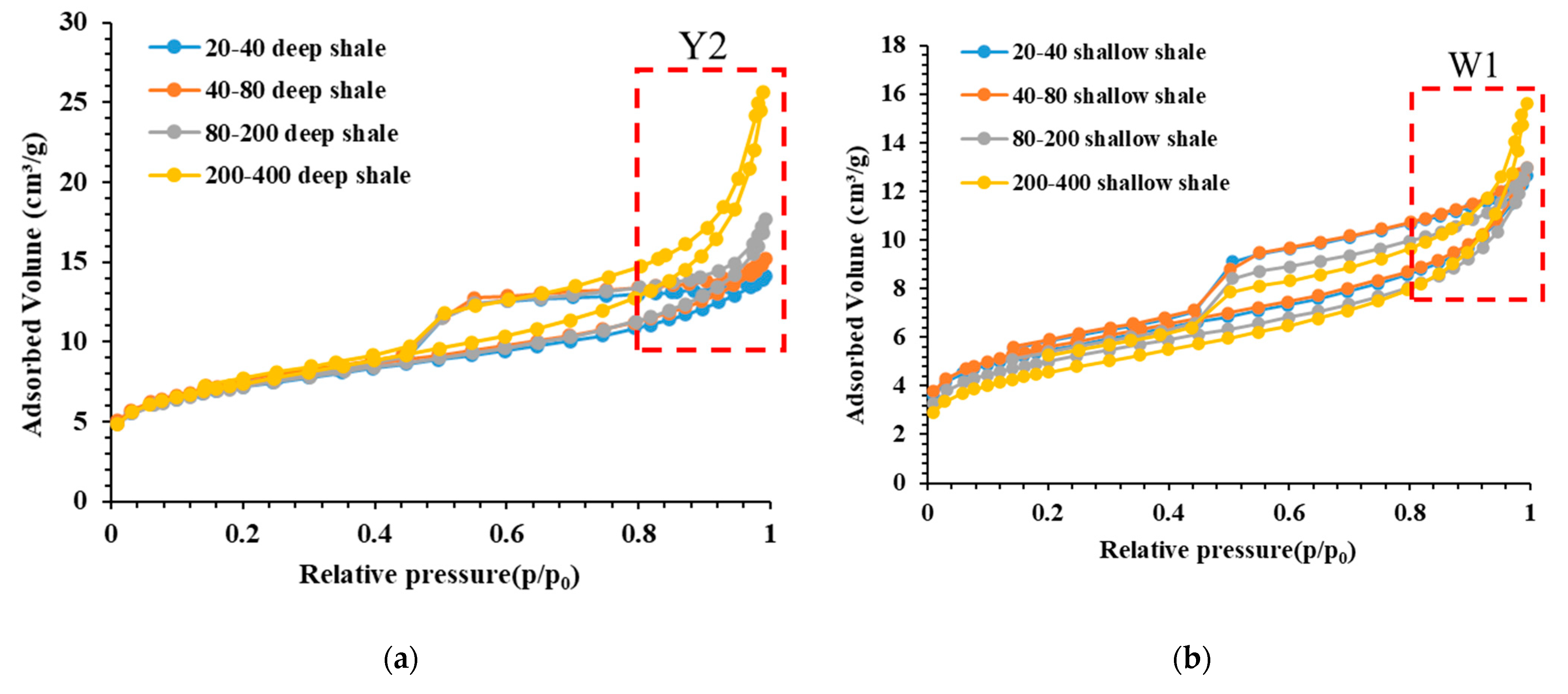



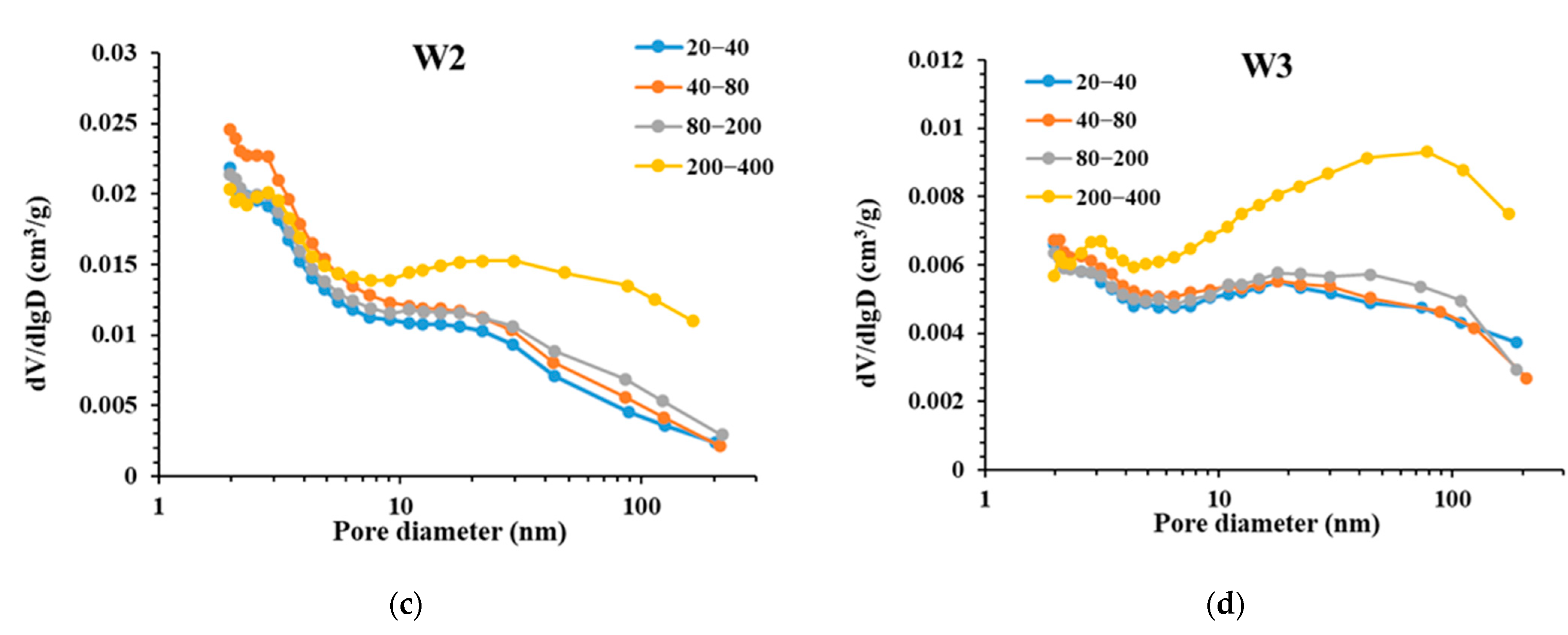
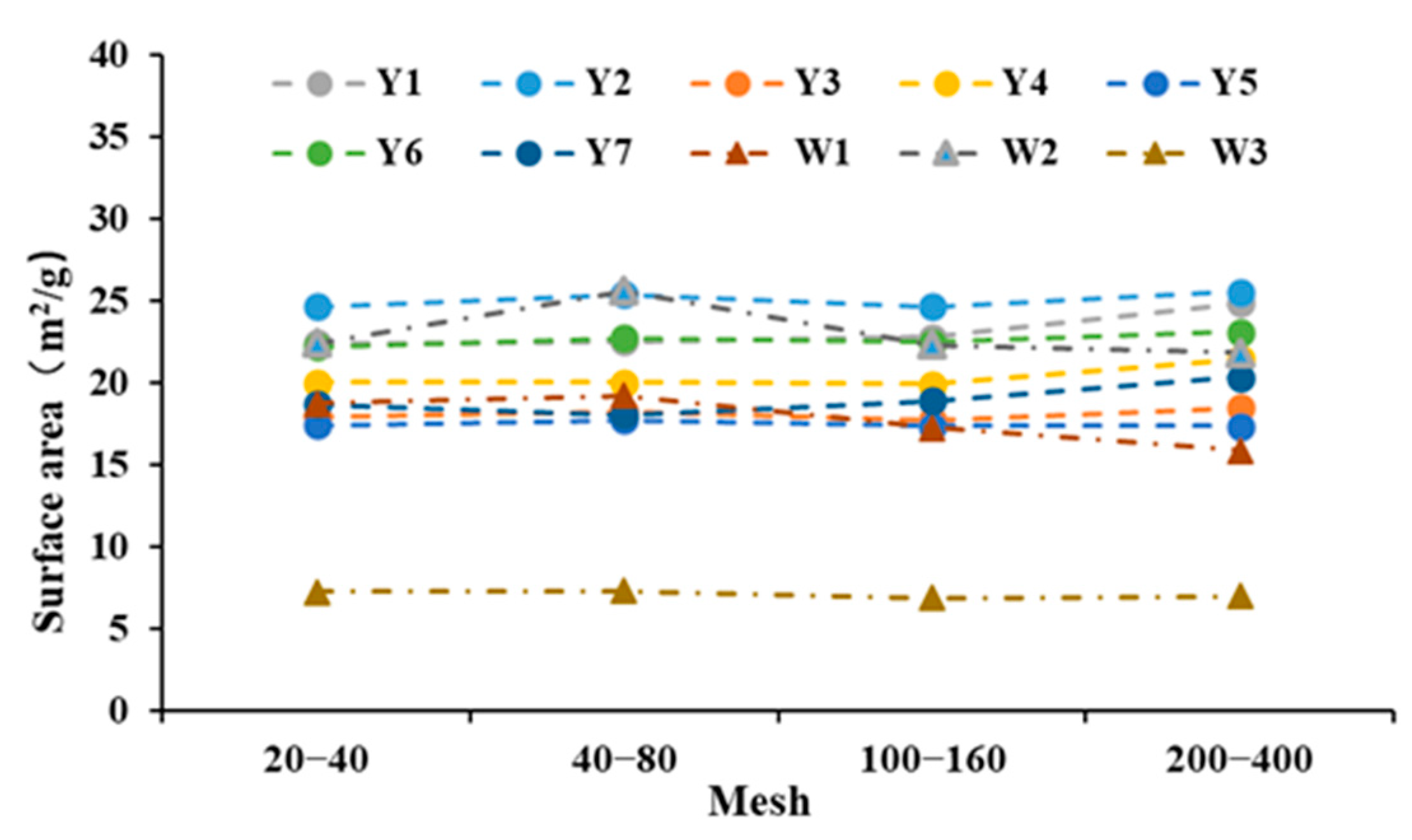


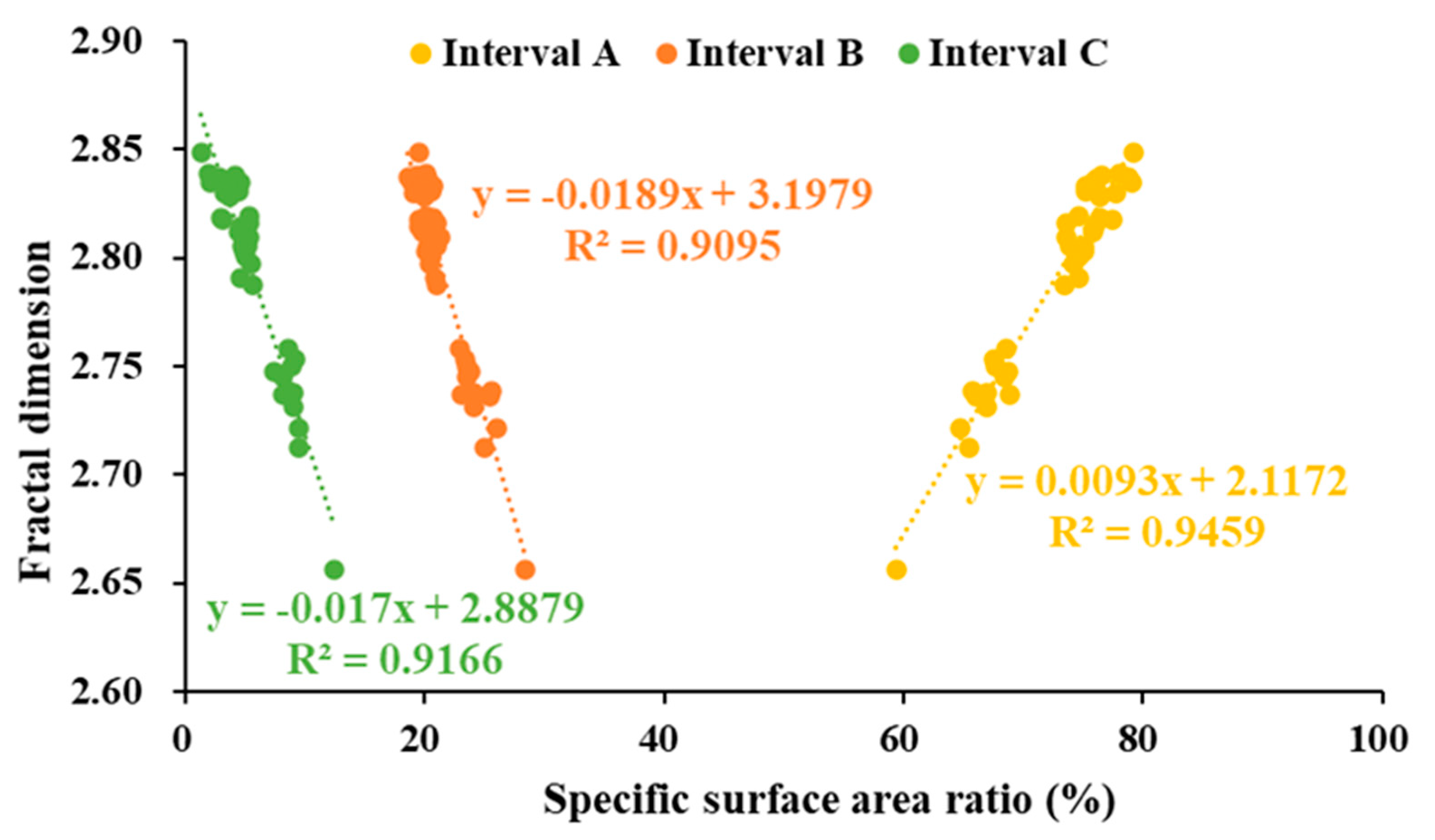
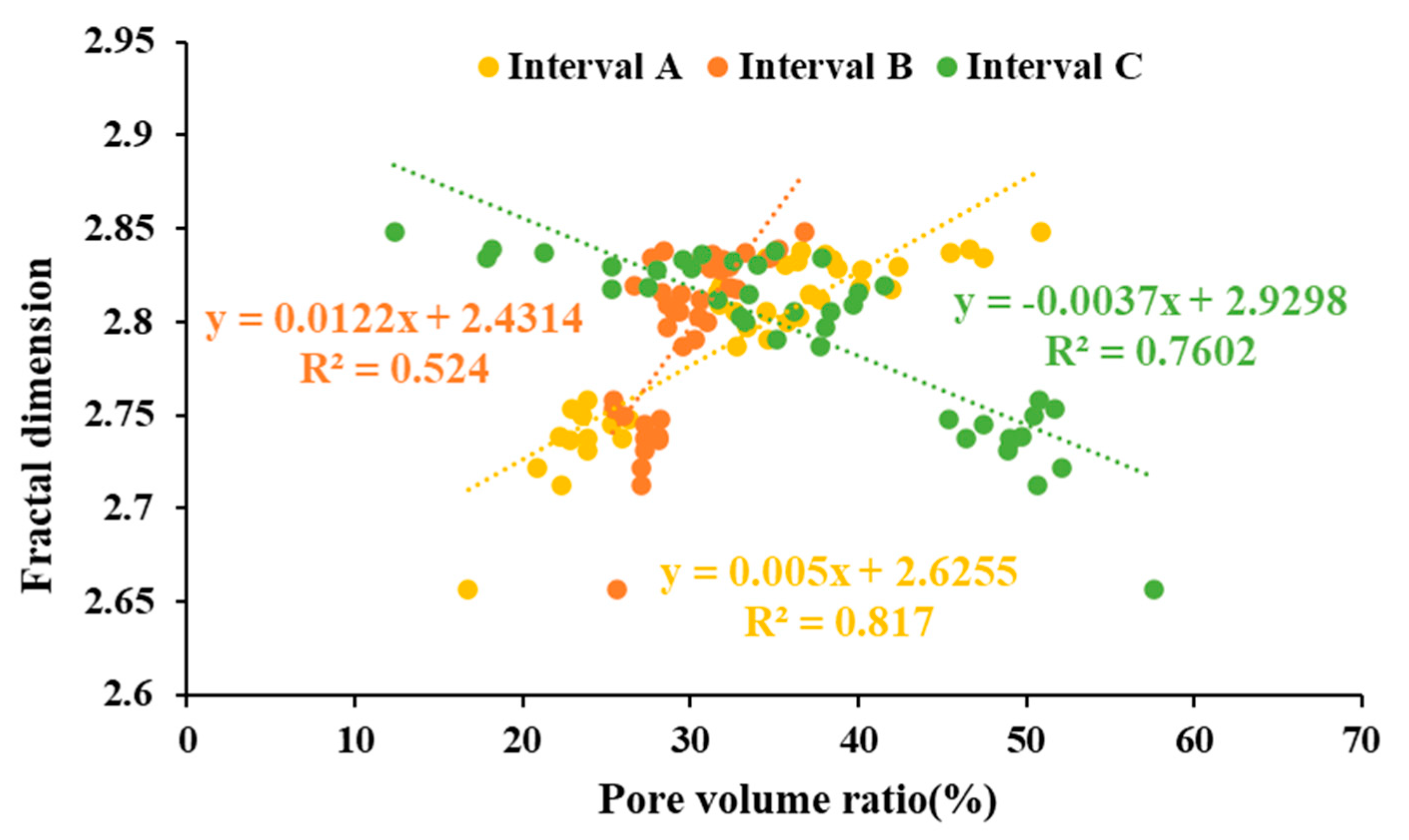

| Sample | Buried Depth (m) | Lithofacies | TOC | Quartz | Total Feldspar | Carbonates | Pyrite | Total Clays | I/S | Illite | Chlorite |
|---|---|---|---|---|---|---|---|---|---|---|---|
| Y1 | 4140 | S | 3.81 | 61.34 | 6.34 | 6.21 | 4.11 | 22.00 | 16.72 | 3.33 | 1.94 |
| Y2 | 4142 | CS | 3.84 | 45.30 | 4.80 | 12.40 | 6.90 | 30.60 | 18.97 | 3.37 | 8.26 |
| Y3 | 4145 | S | 3.57 | 56.98 | 2.52 | 19.67 | 3.02 | 17.81 | 14.79 | 0.60 | 2.42 |
| Y4 | 4146 | S | 3.78 | 57.86 | 3.11 | 27.37 | 3.97 | 7.69 | 5.75 | 0.83 | 1.11 |
| Y5 | 4151 | S | 1.92 | 55.84 | 4.19 | 30.77 | 2.60 | 6.60 | 4.60 | 1.05 | 0.95 |
| Y6 | 4153 | CS | 3.32 | 43.81 | 2.73 | 29.33 | 2.57 | 21.56 | 18.21 | 1.90 | 1.45 |
| Y7 | 4156 | CS | 1.86 | 44.96 | 1.94 | 12.13 | 0.98 | 39.99 | 30.48 | 5.98 | 3.53 |
| W1 | 2567 | C | 4.37 | 12.80 | 0.40 | 63.40 | 15.50 | 7.90 | 5.93 | 0.24 | 1.74 |
| W2 | 2561 | CS | 3.53 | 26.80 | 6.00 | 41.70 | 3.60 | 21.90 | 14.45 | 1.75 | 5.69 |
| W3 | 2544 | C | 1.65 | 14.20 | 2.20 | 65.90 | 3.20 | 14.50 | 10.59 | 0.87 | 3.05 |
| Sample | Mesh | BET Surface Area (m2/g) | DFT Pore Volume | Pore Volume of Interval A (2–5 nm) (cm3/g) | Pore Volume of Interval B (5–20 nm) (cm3/g) | Pore Volume of Interval C (>20 nm) (cm3/g) |
|---|---|---|---|---|---|---|
| Y1 | 20–40 | 22.44 | 0.0168 | 0.00675 | 0.00535 | 0.00470 |
| 40–80 | 22.57 | 0.0173 | 0.00670 | 0.00539 | 0.00519 | |
| 100–160 | 22.85 | 0.0214 | 0.00699 | 0.00620 | 0.00820 | |
| 200–400 | 24.90 | 0.0341 | 0.00811 | 0.00927 | 0.01667 | |
| Y2 | 20–40 | 24.68 | 0.0185 | 0.00769 | 0.00562 | 0.00360 |
| 40–80 | 25.46 | 0.0185 | 0.00784 | 0.00599 | 0.00469 | |
| 100–160 | 24.71 | 0.0229 | 0.00790 | 0.00670 | 0.00826 | |
| 200–400 | 25.59 | 0.0362 | 0.00863 | 0.00988 | 0.01774 | |
| Y3 | 20–40 | 17.99 | 0.0145 | 0.00501 | 0.00417 | 0.00386 |
| 40–80 | 18.33 | 0.0139 | 0.00507 | 0.00434 | 0.00453 | |
| 100–160 | 17.76 | 0.0163 | 0.00516 | 0.00466 | 0.00645 | |
| 200–400 | 18.50 | 0.0244 | 0.00574 | 0.00636 | 0.01230 | |
| Y4 | 20–40 | 20.04 | 0.0161 | 0.00551 | 0.00453 | 0.00444 |
| 40–80 | 20.07 | 0.0178 | 0.00564 | 0.00505 | 0.00714 | |
| 100–160 | 19.94 | 0.0153 | 0.00545 | 0.00462 | 0.00520 | |
| 200–400 | 21.50 | 0.0278 | 0.00638 | 0.00707 | 0.01439 | |
| Y5 | 20–40 | 17.45 | 0.0129 | 0.00472 | 0.00367 | 0.00452 |
| 40–80 | 17.76 | 0.0138 | 0.00475 | 0.00381 | 0.00520 | |
| 100–160 | 17.42 | 0.0155 | 0.00491 | 0.00412 | 0.00642 | |
| 200–400 | 17.42 | 0.0223 | 0.00532 | 0.00567 | 0.01130 | |
| Y6 | 20–40 | 22.26 | 0.0150 | 0.00708 | 0.00512 | 0.00172 |
| 40–80 | 22.76 | 0.0154 | 0.00718 | 0.00544 | 0.00280 | |
| 100–160 | 22.49 | 0.0182 | 0.00731 | 0.00590 | 0.00501 | |
| 200–400 | 23.12 | 0.0296 | 0.00782 | 0.00837 | 0.01345 | |
| Y7 | 20–40 | 18.72 | 0.0143 | 0.00622 | 0.00454 | 0.00233 |
| 40–80 | 18.08 | 0.0145 | 0.00607 | 0.00474 | 0.00367 | |
| 100–160 | 18.95 | 0.0190 | 0.00655 | 0.00573 | 0.00667 | |
| 200–400 | 20.39 | 0.0330 | 0.00736 | 0.00891 | 0.01668 | |
| W1 | 20–40 | 18.81 | 0.0170 | 0.00611 | 0.00494 | 0.00512 |
| 40–80 | 19.26 | 0.0165 | 0.00612 | 0.00486 | 0.00553 | |
| 100–160 | 17.30 | 0.0172 | 0.00573 | 0.00491 | 0.00654 | |
| 200–400 | 15.92 | 0.0221 | 0.00560 | 0.00604 | 0.01051 | |
| W2 | 20–40 | 22.47 | 0.0210 | 0.00749 | 0.00650 | 0.00698 |
| 40–80 | 25.64 | 0.0238 | 0.00869 | 0.00727 | 0.00786 | |
| 100–160 | 22.36 | 0.0235 | 0.00771 | 0.00694 | 0.00887 | |
| 200–400 | 21.89 | 0.0303 | 0.00783 | 0.00837 | 0.01405 | |
| W3 | 20–40 | 7.29 | 0.0107 | 0.00237 | 0.00299 | 0.00530 |
| 40–80 | 7.35 | 0.0111 | 0.00253 | 0.00311 | 0.00543 | |
| 100–160 | 6.92 | 0.0115 | 0.00239 | 0.00311 | 0.00597 | |
| 200–400 | 7.03 | 0.0161 | 0.00269 | 0.00412 | 0.00925 |
| Sample | Mesh | Fractal Dimension | R2 |
|---|---|---|---|
| Y1 | 20–40 | 2.8282 | 0.9311 |
| 40–80 | 2.8287 | 0.9349 | |
| 100–160 | 2.8058 | 0.9589 | |
| 200–400 | 2.7374 | 0.9925 | |
| Y2 | 20–40 | 2.8373 | 0.9063 |
| 40–80 | 2.83 | 0.9226 | |
| 100–160 | 2.8054 | 0.9552 | |
| 200–400 | 2.7309 | 0.992 | |
| Y3 | 20–40 | 2.8336 | 0.9386 |
| 40–80 | 2.8328 | 0.9423 | |
| 100–160 | 2.8096 | 0.9654 | |
| 200–400 | 2.7499 | 0.9922 | |
| Y4 | 20–40 | 2.8366 | 0.9364 |
| 40–80 | 2.816 | 0.9631 | |
| 100–160 | 2.8308 | 0.95 | |
| 200–400 | 2.7536 | 0.9941 | |
| Y5 | 20–40 | 2.8377 | 0.9486 |
| 40–80 | 2.8344 | 0.9552 | |
| 100–160 | 2.8191 | 0.9638 | |
| 200–400 | 2.7579 | 0.9911 | |
| Y6 | 20–40 | 2.8483 | 0.8593 |
| 40–80 | 2.8385 | 0.8881 | |
| 100–160 | 2.8182 | 0.9258 | |
| 200–400 | 2.7473 | 0.9861 | |
| Y7 | 20–40 | 2.8346 | 0.8885 |
| 40–80 | 2.8179 | 0.9218 | |
| 100–160 | 2.7908 | 0.9528 | |
| 200–400 | 2.7128 | 0.9913 | |
| W1 | 20–40 | 2.8119 | 0.9346 |
| 40–80 | 2.8143 | 0.9443 | |
| 100–160 | 2.7973 | 0.9523 | |
| 200–400 | 2.7448 | 0.9748 | |
| W2 | 20–40 | 2.8003 | 0.9481 |
| 40–80 | 2.8031 | 0.9409 | |
| 100–160 | 2.7871 | 0.954 | |
| 200–400 | 2.7371 | 0.9846 | |
| W3 | 20–40 | 2.7383 | 0.9868 |
| 40–80 | 2.7365 | 0.9805 | |
| 100–160 | 2.7214 | 0.9841 | |
| 200–400 | 2.6562 | 0.9938 |
Publisher’s Note: MDPI stays neutral with regard to jurisdictional claims in published maps and institutional affiliations. |
© 2022 by the authors. Licensee MDPI, Basel, Switzerland. This article is an open access article distributed under the terms and conditions of the Creative Commons Attribution (CC BY) license (https://creativecommons.org/licenses/by/4.0/).
Share and Cite
Zhan, H.; Li, X.; Hu, Z.; Duan, X.; Guo, W.; Li, Y. Influence of Particle Size on the Low-Temperature Nitrogen Adsorption of Deep Shale in Southern Sichuan, China. Minerals 2022, 12, 302. https://doi.org/10.3390/min12030302
Zhan H, Li X, Hu Z, Duan X, Guo W, Li Y. Influence of Particle Size on the Low-Temperature Nitrogen Adsorption of Deep Shale in Southern Sichuan, China. Minerals. 2022; 12(3):302. https://doi.org/10.3390/min12030302
Chicago/Turabian StyleZhan, Hongming, Xizhe Li, Zhiming Hu, Xianggang Duan, Wei Guo, and Yalong Li. 2022. "Influence of Particle Size on the Low-Temperature Nitrogen Adsorption of Deep Shale in Southern Sichuan, China" Minerals 12, no. 3: 302. https://doi.org/10.3390/min12030302
APA StyleZhan, H., Li, X., Hu, Z., Duan, X., Guo, W., & Li, Y. (2022). Influence of Particle Size on the Low-Temperature Nitrogen Adsorption of Deep Shale in Southern Sichuan, China. Minerals, 12(3), 302. https://doi.org/10.3390/min12030302






